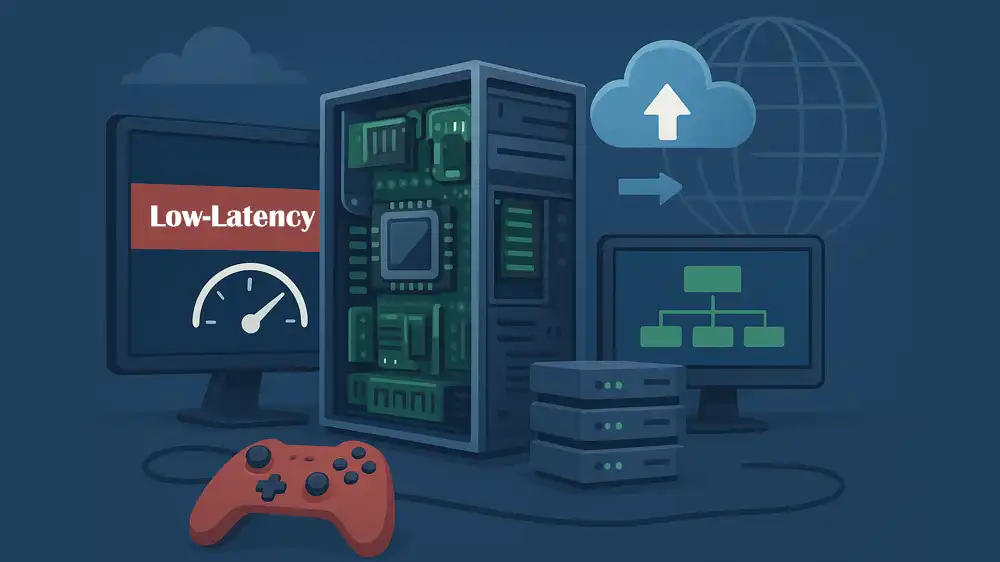
Low Latency Tips for Dedicated Game Servers
Hosting a game server isn’t just about having powerful hardware; it’s about how efficiently that hardware is used to provide fast, responsive gameplay. In online games, latency can make or break the player experience. That is why hosting your game servers on dedicated servers is a better choice than a cloud-based or shared environment. In this guide, we will explore the best low latency tips for dedicated game servers, from setup and configuration to scaling and load balancing.
Table of Contents
Why Dedicated Servers Are Ideal for Gaming?
By using dedicated servers for gaming, you will have full control of everything. You will not share CPU, bandwidth, RAM, and other metrics, which means your game server has consistent performance even during high-load periods. Dedicated servers provide the stability, speed, and flexibility you need for game hosting.
Here are the most important reasons that dedicated servers are the best option for game hosting:
Uninterrupted Performance: With dedicated hardware, only you have access to resources like CPU, RAM, etc., which ensure consistent performance for users.
Low Latency and Stability: Dedicated servers are typically located in data centers with optimized routing, advanced cooling, and power redundancy. This will bring low latency and stability.
Customization: In dedicated servers, you can customize every setting from OS-level network stack configurations to firewall rules and kernel tweaks.
Security control: Because you manage the entire environment in dedicated servers, you can easily enforce strict access policies and updates to reduce vulnerabilities.
Scalability: Also, you can easily scale your environment. Dedicated servers can integrate into clusters or hybrid environments for horizontal scaling.
Low Latency Tips for Dedicated Game Servers Hosting
Once you have chosen a powerful dedicated game server, you must configure your server for low latency. Latency is not just about network speed; it also depends on how well your server is configured.
Here are the most effective tips that you can consider to configure your dedicated game server for minimal delay and maximum stability.
1. Optimizing Network Routes for Dedicated Game Servers
Optimizing network routes is one of the most essential tasks in dedicated game servers. Latency is usually known by how many network “hops” data must take between the player and the server. Each hop introduces potential delay, so optimizing routing paths can make a huge difference in response time.
To optimize network routes, you must:
Select a Host with Strong Peering:
You can choose data centers that peer with Tier 1 ISPs for direct. It provides high-speed routes between major network backbones and reduces the number of hops and improving connection quality.
Use Route Optimization Tools:
Many modern hosting providers offer features like Anycast routing or dynamic BGP optimization, which automatically select the fastest available network paths for incoming and outgoing traffic.
Test Regularly:
Regular testing ensures routing remains efficient and stable. You can use tools like traceroute, mtr, or pingplotter.
Prioritize Game Traffic:
If you manage multiple services on the same machine, configure Quality of Service (QoS) to ensure that gameplay data always gets transmitted first, even under heavy load.
2. Choose Optimal Server Locations For Gaming
Physical distance directly impacts ping times. The closer your players are to the server, the better the response time. It is recommended to set up dedicated servers in key locations like North America, Europe, and Asia.
To reduce the distance and time for real-time interactions, you can use Edge servers or Proxy nodes. Edge computing brings data processing closer to players by handling parts of the workload at distributed nodes. Also, it is recommended to track where your players are connecting from and deploy accordingly.
Measure connection times from various regions to identify the best locations for new deployments.
3. Hardware Recommendations for Low Latency in Dedicated Game Servers
With the right hardware, you will have smooth and consistent performance under all conditions. It is important to consider how quickly your hardware processes game logic and sends responses. Here are the hardware recommendations you can consider for your dedicated game servers:
| Hardware Component | Recommendation | Benefit |
| CPU | High clock-speed Intel Xeon or AMD EPYC | Fast processing of real-time game data. |
| RAM | 32 GB+ ECC DDR5 | Improves stability and prevents data corruption. |
| Storage | NVMe SSD | Provides rapid read/write speeds for loading maps, player states, and assets. |
| Network Interface | 10 Gbps NIC with QoS support | Handles large traffic volumes and ensures steady transmission speeds. |
| Power Supply | Dual PSU | Prevents downtime during hardware failures. |
Note: High-performance hardware minimizes frame drops and transmission delays. It is essential for competitive or real-time multiplayer games.
4. Monitoring and Continuous Optimization in Dedicated Game Servers
Even with the best system configured, the server can degrade over time due to changing conditions, such as player load, network shifts, or software updates. Ongoing monitoring helps you identify and fix issues before players notice them.
To maintain optimal server performance and low latency, it’s important to implement a comprehensive monitoring strategy.
It is recommended to use real-time monitoring tools such as Grafana or Zabbix, set latency threshold alerts, run stress tests to check for server bottlenecks, and keep all software components up to date. Additionally, monitor player feedback to identify issues promptly.
Scaling Dedicated Game Servers without Increasing Latency
Scaling your dedicated game server without increasing latency is essential once your player base grows. Scalability ensures consistent performance under higher loads. You can consider the following tips to scale for more players:
- Horizontal Scaling: Add more dedicated servers instead of relying on one powerful machine. Distributing players across multiple nodes prevents overload. You can check this guide to get more detailed information about Horizontal scaling in Dedicated Servers.
- Autoscaling Systems: You can use automation tools like Terraform, Ansible, or Kubernetes to dynamically add or remove servers. This guide will help you automate dedicated servers with Terraform and Ansible.
- Region-Based Sharding: Assign players to servers in their geographic region to reduce data travel distance and improve responsiveness.
- Data Synchronization: Use lightweight synchronization protocols to maintain a consistent game state across regions.
- Load Testing: Regularly simulate high-traffic scenarios to measure latency under stress.
- Predictive Scaling: Analyze player patterns to pre-scale during peak hours.
Load Balancing Strategies for Low Latency in Dedicated Game Server
When multiple servers are running, managing how traffic is distributed becomes important. A smart load-balancing strategy ensures efficient resource usage and minimal ping for players across regions. Here are the load-balancing methods that ensure consistently low latency for every player:
Latency-Based Routing: Use latency-aware load balancers to direct players to the server that provides the lowest ping. You can:
- Implement tools like HAProxy, NGINX, or Envoy for intelligent routing.
- Use geolocation-based DNS so users connect automatically to the nearest region.
- Continuously update routing data based on live latency metrics.
Session Persistence (Sticky Sessions): In gaming, connection stability is essential. Players should remain connected to the same server throughout their match. You can:
- Configure sticky sessions using IP hashing or tokens.
- Avoid mid-game server transfers that can introduce lag spikes.
Adaptive Load Balancing: Instead of fixed routing, use algorithms that adapt to Current server load, Real-time ping rates, Player region, and Network congestion. This real-time balancing ensures no single server is overloaded while keeping latency minimal for all players.
Failover and Redundancy: To maintain uptime and reliability, deploy secondary load balancers, run automatic health checks to remove failing nodes, and use active-active or active-passive redundancy setups.
Global and Local Load Balancing: Global Load Balancing handles distributing players across continents, and Local Load Balancing manages connections within the same region.
With these methods together, you will have a seamless worldwide experience with consistently low latency.
FAQs
What is low latency in gaming?
Low latency means minimal delay between a player’s action and the game’s response. Generally, a ping under 50ms is considered excellent for online gaming.
How much bandwidth do I need for a game server?
It depends on player count and game type, but 1 Gbps minimum is standard.
Can cloud servers deliver low latency like dedicated servers?
They can, but not as consistently as dedicated servers. Virtualization layers and shared bandwidth can introduce unpredictable latency.
Final Words
Following the best low latency tips for dedicated game servers can bring huge differences. By selecting the right hardware, optimizing network routes, monitoring continuously, scaling strategically, and implementing smart load balancing, you create an environment for fast, reliable, and lag-free gameplay.
A perfectly configured dedicated server doesn’t just improve performance; it builds trust and increases player experience. If you are looking for a reliable and powerful dedicated server for your game hosting, you can check PerLod Hosting Services.
We hope you enjoy this guide. Subscribe to X and Facebook channels to get the latest updates and articles.

